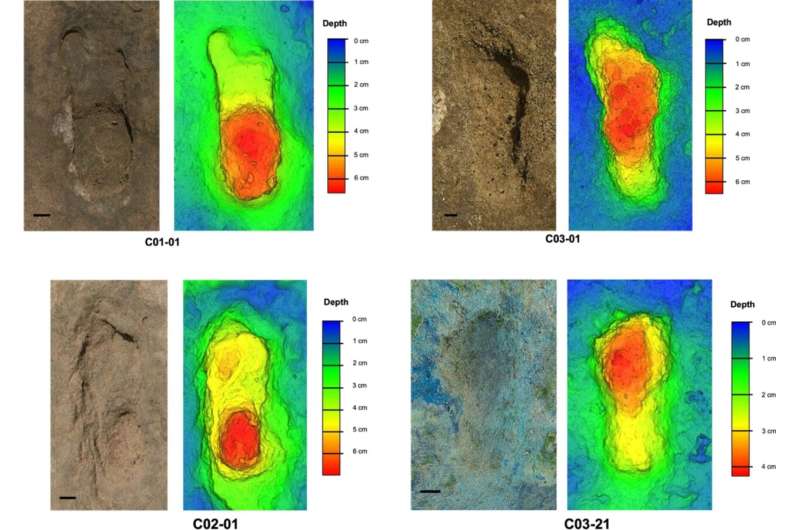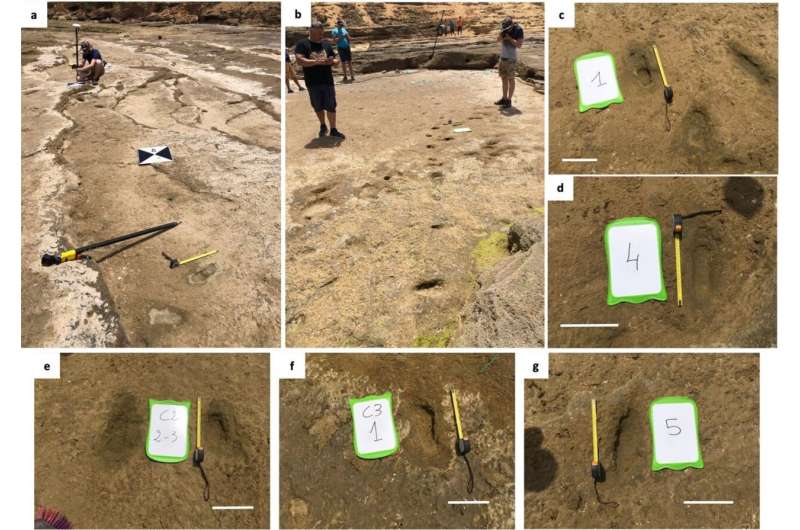90,000-year-old human footprints found on Moroccan beach
An international team of archaeologists has found and identified a trackway made by multiple humans approximately 90,000 years ago in what is now Morocco. In their paper published in the journal Scientific Reports, the group describes how they tested for its origins of the tracks.
Finding footprints left behind by people thousands of years ago is extremely rare due to their generally ephemeral nature. Still, occasionally, events will transpire to preserve footprints, such as encasement in sediment that hardens. Such prints can then over time be revealed as the material that once hid them erodes away. In this instance, the footprints were found in a sandy tract on a rocky part of the Moroccan shoreline.
As is often the case with archaeological finds, the tracks were found by accident. The research team happened to be in the area studying boulders near the ocean when they noticed an indentation in a nearby stretch of sand. A closer look revealed more indentations, which turned out be human footprints.

Intrigued by their find, the team studied the footprints using optically stimulated luminescence and found that they had been made approximately 90,000 years ago, during the Late Pleistocene.
Further study of the tracks showed that they had been made by at least five people. They also found that the tracks had been made by people of different ages, including children, adolescents and adults. And because they represented people walking, rather than a simple footprint, they were designated as a trackway. The trackway is the only known human trackway from that time in history in that part of the world.
The research team suggests preservation of the trackway occurred due to a number of factors, such as the location, the composition of the sediment, the position of the beach relative to the sea, the tides and likely other unknown events. Also unknown was what the group of people were doing on the beach or why they were there. Possibilities include searching for food or perhaps cooling off. Or they might have simply been traveling through the area and found a beach route the easiest to navigate.
More information:
Mouncef Sedrati et al, A Late Pleistocene hominin footprint site on the North African coast of Morocco, Scientific Reports (2024). DOI: 10.1038/s41598-024-52344-5
© 2024 Science X Network
Citation:
90,000-year-old human footprints found on Moroccan beach (2024, January 31)
retrieved 31 January 2024
from https://phys.org/news/2024-01-year-human-footprints-moroccan-beach.html
This document is subject to copyright. Apart from any fair dealing for the purpose of private study or research, no
part may be reproduced without the written permission. The content is provided for information purposes only.

An international team of archaeologists has found and identified a trackway made by multiple humans approximately 90,000 years ago in what is now Morocco. In their paper published in the journal Scientific Reports, the group describes how they tested for its origins of the tracks.
Finding footprints left behind by people thousands of years ago is extremely rare due to their generally ephemeral nature. Still, occasionally, events will transpire to preserve footprints, such as encasement in sediment that hardens. Such prints can then over time be revealed as the material that once hid them erodes away. In this instance, the footprints were found in a sandy tract on a rocky part of the Moroccan shoreline.
As is often the case with archaeological finds, the tracks were found by accident. The research team happened to be in the area studying boulders near the ocean when they noticed an indentation in a nearby stretch of sand. A closer look revealed more indentations, which turned out be human footprints.

Intrigued by their find, the team studied the footprints using optically stimulated luminescence and found that they had been made approximately 90,000 years ago, during the Late Pleistocene.
Further study of the tracks showed that they had been made by at least five people. They also found that the tracks had been made by people of different ages, including children, adolescents and adults. And because they represented people walking, rather than a simple footprint, they were designated as a trackway. The trackway is the only known human trackway from that time in history in that part of the world.
The research team suggests preservation of the trackway occurred due to a number of factors, such as the location, the composition of the sediment, the position of the beach relative to the sea, the tides and likely other unknown events. Also unknown was what the group of people were doing on the beach or why they were there. Possibilities include searching for food or perhaps cooling off. Or they might have simply been traveling through the area and found a beach route the easiest to navigate.
More information:
Mouncef Sedrati et al, A Late Pleistocene hominin footprint site on the North African coast of Morocco, Scientific Reports (2024). DOI: 10.1038/s41598-024-52344-5
© 2024 Science X Network
Citation:
90,000-year-old human footprints found on Moroccan beach (2024, January 31)
retrieved 31 January 2024
from https://phys.org/news/2024-01-year-human-footprints-moroccan-beach.html
This document is subject to copyright. Apart from any fair dealing for the purpose of private study or research, no
part may be reproduced without the written permission. The content is provided for information purposes only.
